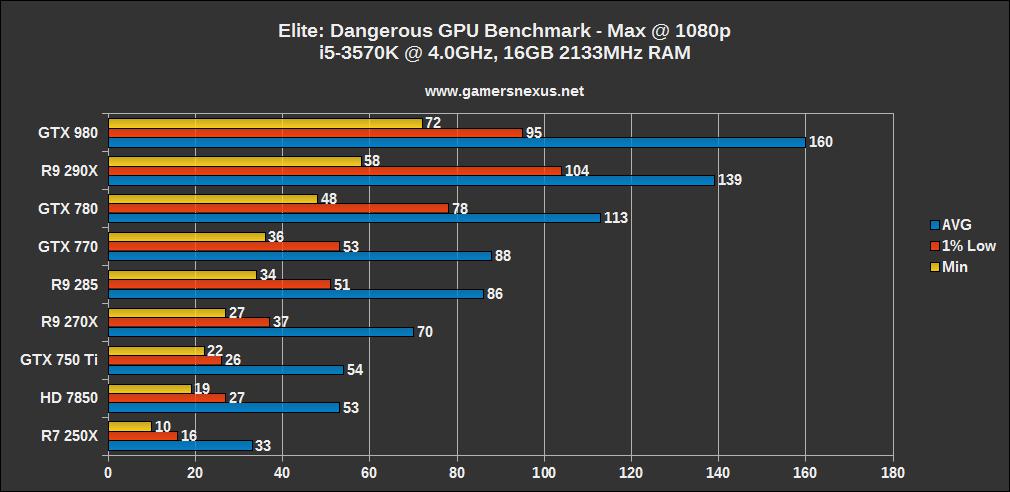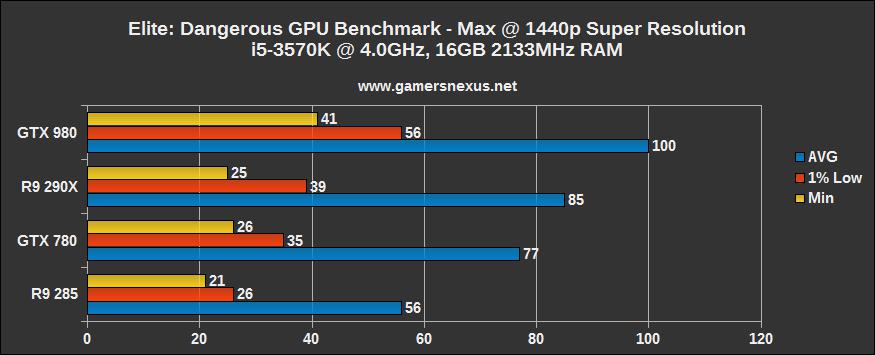Elite: Dangerous GPU Benchmark – Extremely Optimized, Tested at 4K
Posted on December 18, 2014
Elite: Dangerous is one of the best-optimized games we've tested this year, right up there with GRID: Autosport. The game is a member of the impending cluster of space sim and space-flight combat games actively being developed. Like Star Citizen, Elite: Dangerous comes from the designers of a game that's decades-old, 1984's “Elite.”
With Elite: Dangerous' official launch, we've put the game on our GPU bench to test the FPS on various graphics card configurations, including an R7 250X, 270X, GTX 750 Ti, GTX 980, and more. In addition to our usual video settings tests, we ran Elite: Dangerous using AMD's VSR and nVidia's DSR (super resolution) to render output at 4K. These tests are representative of performance yield on a true 4K display. Our crash fix guide may be useful to those who are experiencing issues running Elite: Dangerous.
The game isn't nearly as GPU-intensive as Star Citizen's current alpha build (which we also benchmarked), but still warranted testing.
Elite: Dangerous Max Graphics Settings Benchmark at 1440p
The above video shows Elite: Dangerous at maxed-out settings with 1440p super resolution (filtered down to 1080) on a GTX 980. Tests were also conducted at 4K and 1080p.
Test Methodology
For this test, we varied the Elite: Dangerous settings between 1080p, 1440p, and 4K using super resolution tech. We tested each video card for 120 seconds in an identical circuit on the Launch training mission, using max settings and 4xAA.
We used FRAPS' benchmark utility for real-time measurement of the framerate, then used FRAFS to analyze the 1% high, 1% low, min, max, and average FPS.
NVidia 347.09 stable drivers were used for all tests conducted on nVidia's GPUs. AMD Catalyst Omega drivers were used for the AMD cards.
| GN Test Bench 2013 | Name | Courtesy Of | Cost |
| Video Card | (This is what we're testing). XFX Ghost 7850 | GamersNexus, AMD, NVIDIA, CyberPower, ZOTAC. | Ranges |
| CPU | Intel i5-3570k CPU Intel i7-4770K CPU (alternative bench). | GamersNexus CyberPower | ~$220 |
| Memory | 16GB Kingston HyperX Genesis 10th Anniv. @ 2400MHz | Kingston Tech. | ~$117 |
| Motherboard | MSI Z77A-GD65 OC Board | GamersNexus | ~$160 |
| Power Supply | NZXT HALE90 V2 | NZXT | Pending |
| SSD | Kingston 240GB HyperX 3K SSD | Kingston Tech. | ~$205 |
| Optical Drive | ASUS Optical Drive | GamersNexus | ~$20 |
| Case | Phantom 820 | NZXT | ~$130 |
| CPU Cooler | Thermaltake Frio Advanced | Thermaltake | ~$65 |
The system was kept in a constant thermal environment (21C - 22C at all times) while under test. 4x4GB memory modules were kept overclocked at 2400MHz. All case fans were set to 100% speed and automated fan control settings were disabled for purposes of test consistency and thermal stability.
A 120Hz display was connected for purposes of ensuring frame throttles were a non-issue. The native resolution of the display is 1920x1080. V-Sync was completely disabled for this test.
A few additional tests were performed as one-offs to test various graphics settings for impact.
The video cards tested include:
- AMD Radeon R9 290X 4GB (provided by CyberPower).
- AMD Radeon R9 270X 2GB (we're using reference; provided by AMD).
- AMD Radeon HD 7850 1GB (bought by GamersNexus).
- AMD Radeon R7 250X 1GB (equivalent to HD 7770; provided by AMD).
- NVidia GTX 780 Ti 3GB (provided by nVidia).
- NVidia GTX 770 2GB (we're using reference; provided by nVidia).
- NVidia GTX 750 Ti Superclocked 2GB (provided by nVidia).
- GTX 980 4GB
- AMD R9 285 2GB.
Elite: Dangerous FPS Performance @ 1080 – GTX 980, 770, 750 Ti vs. 250X, 270X, 285
At 1080p, we found Elite: Dangerous to be playable on effectively every budget or better video card. Even last generation's 1GB 7850 played at 53 average FPS, an impressive feat for what was once a $130 video card. The 250X lands in “unplayable” territory on max settings, but dropping to medium settings resolves this and puts us closer to a consistent 50FPS.
As expected, the GTX 980 runs largely unfettered by the game, limited only by the CPU. Assuming your target framerate is 60FPS, target resolution is 1080p, and preferred settings are “max,” our minimum purchasing suggestions would be AMD's R9 270X 2GB ($165) or nVidia's GTX 750 Ti 2GB ($140) / GTX 760 2GB ($190). The 270X exhibits stellar performance at the price-point.
Elite: Dangerous Max Settings FPS @ 1440 & 4K VSR / DSR
Using the new super resolution technology from both major GPU vendors, we're able to force render the output at higher resolutions and then filter it back down to the native display resolution. The scaler and filtration process is removed from the graphics pipeline, so the FPS impact is representative only of what would be experienced on a true 1440 or 4K display. NVidia's DSR exhibits about a 1% FPS drop during the filtration process; AMD exhibits no additional filtration FPS drop due to the location of the scaler in the render pipeline.
This allows for accurate simulation of a true 1440 or 4K experience, which is what we've got to use until a point when we have higher resolution displays available for testing. VSR & DSR also improve overall graphics fidelity, largely by eliminating jagged edges on skinnier objects (railing, grass, things like that).
At 1440p, all devices suffer from a large and immediate performance drop. We tested with SMAA and 4xMLAA, both of which yielded similar results (read: performance difference within 10 frames) despite the significantly increased pixel count.
All devices tested were deemed “playable” at 1440p resolutions, including AMD's new R9 285 GPU ($240) and nVidia's last-gen GTX 780.
Because VSR is not available on the R9 290X, we could only test the R9 285 at 4K resolution against the GTX 980. Both are questionable in performance, though a few settings tweaks would make the GTX 980 playable at 4K (“high” settings with SMAA should do it). The R9 285 is unplayable at 4K.
Noticeable Tearing Issues on All GPUs
Unlike our experience in Far Cry 4, frame tearing was GPU-agnostic and prevalent throughout Elite: Dangerous and on all devices. We imagine this will only be resolved with game patches going forward. The display will also occasionally exhibit a noticeable “vertical scan” upward as frames are drawn, resulting in a somewhat displeasing gaming experience. We hope that the Elite: Dangerous team can patch this up shortly.
What's the Best Graphics Card for Elite: Dangerous?
Overall, the game loads the GPU minimally and doesn't seem to do much with the CPU, either – though certainly a bit more than other games. For users playing at 1080p on max settings with a minimum 60FPS requirement, we'd recommend the R9 270X ($165) as the highest cost-to-performance solution. If you're OK with turning a few settings down to “high” or “medium” from our tested ultra & high options, the GTX 750 Ti ($140) will easily support Elite: Dangerous at 60FPS with tweaking. We'd recommend an nVidia GTX 770 ($285) or AMD R9 285 ($240).
- Steve "Lelldorianx" Burke.


